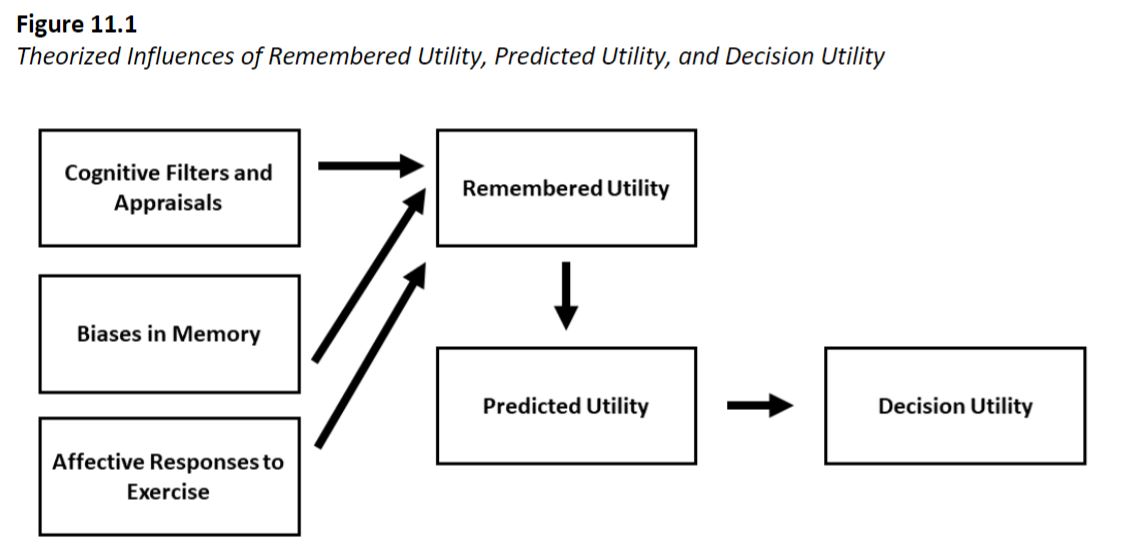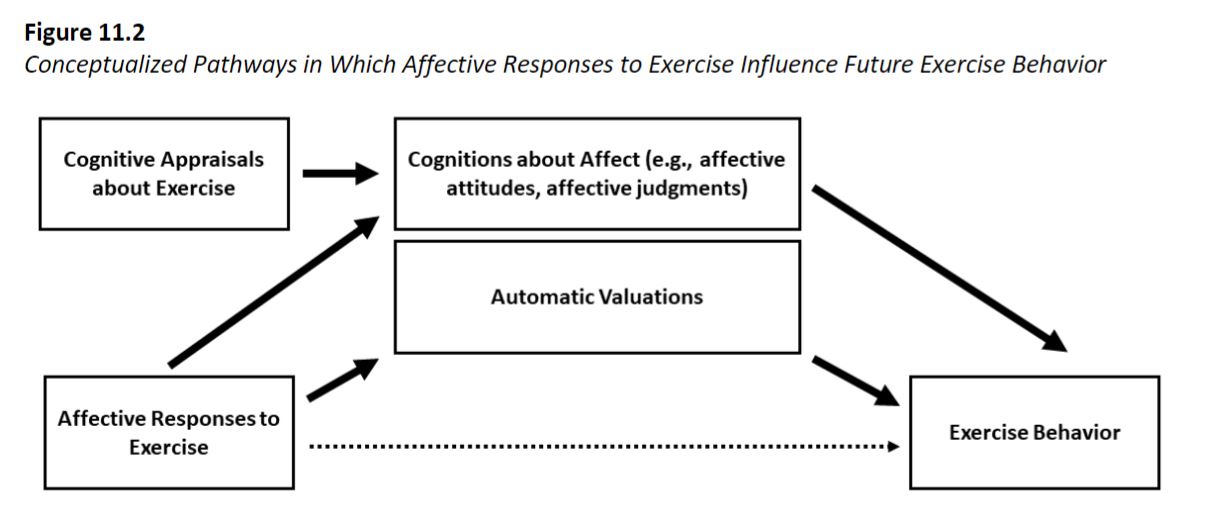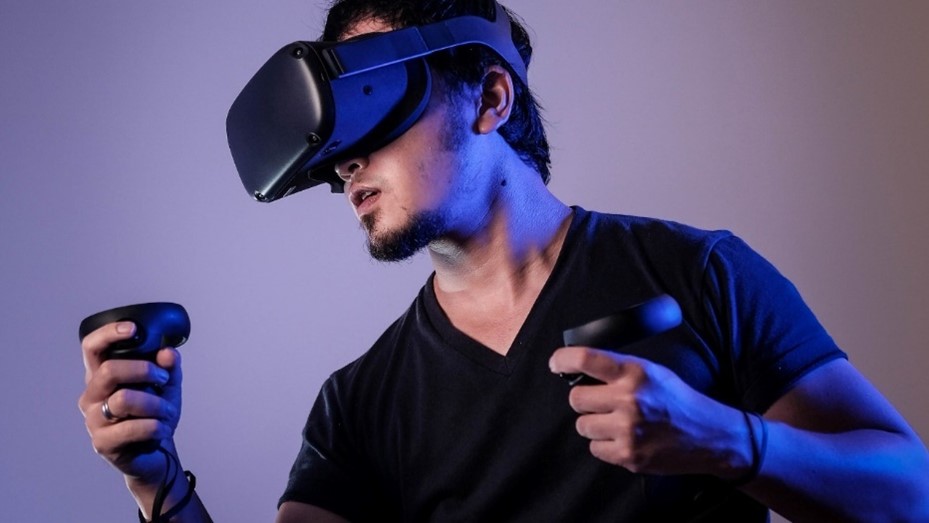Chapter 11: Strategies to Facilitate More Pleasant Exercise Experiences
Chapter Overview
Introduction
The Importance of Pleasant Exercise Experiences
Memories of the Past, Decisions about the Present
Figure 11.1
Figure 11.2
Automatic Affective Valuations
Strategies to Facilitate More Pleasant Exercise Experience
Intensity and Affective Responses to Exercise
Self-Selected and Affect-Guided Exercise Intensity
Restructuring Exercise Intensity
Learning Exercise Two
Extrinsic Strategies
Indoor and Outdoor Exercise
Purposefully Selected Visual Stimuli
Virtual Reality and Immersive Environments
Learning Exercise Three
Music
Exergaming
Exercising with Others
Imagery
Mindfulness
Other Strategies
Conclusion
Strategies to Facilitate More Pleasant Exercise Experiences
Chapter Overview
- There is broad acknowledgement that how we feel during exercise is a predictor of long-term adherence.
- In this chapter, we describe the evidence that leads us to focus on the promotion of pleasant exercise experiences as an important strategy for long-term exercise adherence.
- This is followed by a discussion of modifications that can be made to exercise itself (intrinsic) and to the exercise environment (extrinsic) with the aim of influencing how people feel during exercise.
- Exercise intensity is the predominant intrinsic strategy that we focus on given its central role in determining our affective responses to exercise. We discuss a range of extrinsic strategies including indoor and outdoor exercise, exercising with others, virtual reality, music, imagery, and exergaming, among others.
- We aim to provide a broad overview of the available strategies that researchers and practitioners can implement to help foster more consistently pleasant and enjoyable exercise experiences.

Introduction
- As a society, we spend considerable time, effort, and financial resources to shift inactive people towards physical activity. However, if the experience of physical activity is unpleasant, then we have likely wasted much of that time, effort, and money, as unpleasant experiences are unlikely to promote long-term adherence.
- A substantial portion of the literature relating to exercise interventions focuses on helping people to initiate exercise, whereas there is less focus on what to do once people begin exercising; that is, the strategies we can employ to influence how people feel during exercise.
- This chapter discusses intrinsic and extrinsic strategies to facilitate pleasant and enjoyable exercise experiences.
The Importance of Pleasant Exercise Experiences
- Although engaging in exercise may be of great benefit for our long-term health and well-being, the tendency of humans to maximize pleasure may lead them to suboptimal or nonrational decisions and behaviors (Cabanac & Bonniot-Cabanac, 2007). In the case of exercising, this tendency may result in a person choosing a sedentary, but suboptimal, alternative.
- As with other behaviors, affective responses are related to current and predictive of future exercise behavior (Williams et al., 2012).
- Maximizing pleasure experienced during exercise may be the most influential correlate of future physical activity behavior.
Memories of the Past, Decisions about the Present
- When making decisions and choices about behavior—such as the decision to exercise or not—it is important to acknowledge that decision makers may be biased, and the memories of pleasure and displeasure experienced during earlier exercise episodes may be distorted through cognitive filters and other biases in memory.
- An exercise experience that is more pleasant has higher experienced utility than a less pleasant (or more unpleasant) exercise session. Decision utility is inferred from the choices people are observed to make.
- A large research literature suggests that decision utility is not a direct result of experienced utility. Instead, it is possible that an experience such as exercising can be remembered differently (e.g., as more or less positive than it actually was), and this remembered utility may inform predicted utility (i.e., predictions about how pleasant or unpleasant future exercise experiences will be), which in turn may inform decision utility (i.e., whether someone chooses to exercise, or not).
Figure 11.1

Memories of the Past, Decisions about the Present (continued)
- Memories of an activity or event may be biased by many factors, such as the temporal characteristics of an exercise experience (described later), as well as cognitive filters and cognitive appraisals, including individual biases and cognitive appraisals about the importance of exercise (Karnaze et al., 2017), and individual differences such as personality.
- Cognitively mediated variables such as remembered utility (e.g., “How did the exercise make you feel?”), predicted utility, affective forecasts, or anticipated affective responses (e.g., “How will the exercise make you feel?”), and other affect-laden cognitive constructs such as affective attitudes and affective judgments may be influenced at least in part by previous affective responses to exercise experiences, but affective responses to exercise are not the only determinant of these cognitive constructs.
Figure 11.2

Automatic Affective Valuations
- According to affective-reflective theory, automatic affective valuations are automatic positive or negative associations with physical activity or exercise.
- The positivity or negativity may be the “result of repeated experiences of emotions mediated by cognitive appraisals or a result of repeated exercise experiences of core affective reactions not necessarily mediated by cognitive appraisals physical reinvigoration, pain, bodily discomfort” (Brand & Ekkekakis, 2018, p. 54).
- In turn, automatic affective valuations serve as a predictor of physical activity or exercise behavior. Therefore, based on the affective-reflective theory, automatic affective valuations serve as a link and mediate the relation between affective responses to exercise and exercise behavior.
- Taken together, it seems imperative that practitioners should maximize the pleasure experienced during exercise because affective responses to exercise are predictive of future exercise behavior; this relationship is likely mediated by cognitions about affect and automatic affective valuations
Strategies to Facilitate More Pleasant Exercise Experience
- To fully target affective responses to exercise, one must make the experience of exercise more pleasant (Ekkekakis et al., 2018).
- Here, we describe two broad strategies that are:
- (a) Focused on intensity factors (Intrinsic)
- (b) Focused on situational and environmental factors (Extrinsic)
Intensity and Affective Responses to Exercise
- The dual-mode theory (DMT; Ekkekakis, 2005; 2009a) suggests that affective responses to exercise are influenced by cognitive factors, such as appraisals about exercise, goals, and perceptions of accomplishment, and interoceptive factors, such as physiological responses to exercise.
- When intensity is moderate (i.e., below the lactate threshold or ventilatory threshold), exercise is “consistently beneficial and it is essential for subsistence activities and promotes the healthful effects of exercise without seriously challenging the maintenance of homeostasis or raising the risk of injury or exhaustion” (p. 82).
- Exercise in the heavy domain is neither consistently beneficial nor dangerous, and therefore affective responses in the heavy domain are often highly variable, with cognitive factors being more closely related to affective responses during heavy exercise (Ekkekakis et al., 2005b; Ekkekakis, 2009a)
- These intensities are expected to elicit either (a) homogenous, consistent feelings of displeasure (severe intensity) or (b) heterogenous, mixed feelings of displeasure and pleasure (heavy intensity).
- Ekkekakis and colleagues (2011) suggested that the likelihood of exercise intensity to elicit pleasure or displeasure should be a primary consideration for practitioners, alongside exercise safety and exercise effectiveness.

Self-Selected and Affect-Guided Exercise Intensity
- When allowed to self-select their own exercise intensity, most (but not all) people select intensities that are both physiologically beneficial and not expected to elicit displeasure (Ekkekakis, 2009b).
- In a randomized controlled trial by Williams and colleagues (2016), it was found that self-paced exercisers had more positive affective responses to exercise, and these more positive affective responses mediated the relationship between the type of exercise program (i.e., self-paced vs. moderate intensity) and exercise adherence.
- Another, more direct method of prescribing exercise that results in positive affective responses may be to simply guide exercisers to choose an intensity that feels good. This is affect-based, affect-regulated, or affect-guided exercise (Ladwiget al., 2017).
Restructuring Exercise Intensity
- Certain temporal characteristics may have disproportionate influence on how an exercise experience is remembered. Some of these characteristics include the end, or final moment of an experience, the peak, or most intense moment of an experience, and the trend or slope of an experience (Ariely & Carmon, 2000; Kahneman et al., 1993).
- Applied to exercise, the importance of the peak-end rule and the trend or slope suggests that experiences should have a more pleasant “peak” moment, end on a positive note, and improve throughout an experience.
- Zenko, Ekkekakis, and Ariely (2016) tested some of these concepts and found that exercisers who decreased intensity over time (and increased pleasure) remembered the experience to be more pleasurable, predicted future exercise experiences to be more pleasurable, and enjoyed the exercise more.
- Stuntz and colleagues (2020) examined patterns of perceived exertion, feelings of accomplishment, and affective responses in the context of a practice session for college athletes and found when the athletes exerted themselves more and felt more accomplished, they also experienced greater remembered pleasure. Thus, the pattern of intensity is not the only predictor of remembered pleasure and remembered utility

Extrinsic Strategies
- In the context of this chapter, an extrinsic strategy concerns manipulation of the exercise experience outside of frequency, intensity, duration, and type.
- In practice, strategies are often combined to create interventions, and in many instances more than one strategy is included in a research study which can make isolating the effects of a specific strategy difficult.
- For example, a person attending a spin class could experience several extrinsic factors: the music played, the other participants in the class, the instructor, the room set up (e.g., mirrors, lighting), and each would influence a person’s responses to the spin class. This is in addition to intrinsic factors such as exercise intensity, and other factors previously mentioned in this chapter.
- The interaction of these factors leads to difficulties in predicting responses to such situations. Nonetheless, researchers have sought to understand the affective responses to extrinsic strategies that could be employed during exercise.
Indoor and Outdoor Exercise
- The environment in which people exercise is complex and includes numerous different sources of information (e.g., scenery, weather). However, the dichotomy of indoor or outdoor exercise can be useful when trying to understand affective responses to the physical environments where people exercise.
- Comparisons between indoor and outdoor exercise are popular but there have been equivocal findings regarding affective responses during exercise. A systematic review by Lahart et al. (2019) supported the view that acute bouts of outdoor exercise have favorable affective responses compared to indoor exercise but concluded that low quality evidence pervaded the field, and that further rigorous research is required.
- There are also studies exploring different outdoor environments (e.g., Green Exercise, Blue Exercise), but the outcomes in these studies are often not captured with dimensional measures of affect or measures of enjoyment.
Purposefully Selected Visual Stimuli
- Research into the effects of showing digital images and videos of the natural environment to people exercising indoors is an attempt to bring the benefits found in some outdoor exercise studies, to indoor exercise.
- Watching point-of-view video footage of traveling through a national park while cycling on an ergometer was not found to increase pleasure compared to a control condition (Jones et al., 2014). However, when the video footage was combined with a motivational music playlist, there were significant positive effects on pleasure compared to a control condition.
- It is apparent that visual stimuli by itself has been the subject of few studies, and the scant evidence available to date suggests that visual stimuli by itself has limited capacity to positively influence how we feel during exercise
Virtual Reality and Immersive Environments
- The recent emergence of low-cost consumer level headsets has led to a resurgence of interest in how virtual reality and immersive environments can be used in an exercise context.
- A comparison between a control condition (no stimulus), watching music videos on a television screen while listening to the music through speakers (low-immersion), and watching the music videos in the head-mounted display while listening to the music via headphones (high-immersion) showed that being highly immersed increased pleasure during exercise (Jones & Ekkekakis, 2019).
- The benefit of virtual nature during exercise does not seem to be in replacing outdoor exercise, but rather when outdoor exercise in pleasant environments is not possible or feasible.
Music
- Music is arguably the most popular accompaniment to exercise and is a topic that garners considerable interest from the public and researchers.
- Music can be applied prior to exercise but the carry-over effects into exercise are not well understood; at present it appears that the most efficacious way for music to influence how people feel during exercise, is to listen during exercise.
- Listening to music during exercise can be divided into two different applications: synchronous and asynchronous. Karageorghis and colleagues (2009) found that a playlist of motivational music tracks, rather than motivationally neutral tracks, applied synchronously, resulted in the highest reported pleasure during the task compared to a no-music control condition.
- Tempo is thought to be the most influential musical factor over the consequences (e.g., positive affective states) of listening during an exercise task; however, the recent meta-analysis by Terry et al. (2020) found that music tempo did not significantly moderate affective responses, and additional work could be undertaken to further understand the role of tempo in determining affective responses.

Exergaming
- Combining computer games with physical activity—known as exergaming—has proved to be a popular strategy with many people, and a lucrative strategy for technology companies such a Nintendo and Microsoft.
- The literature examining exergaming invested a common outcome measure is energy expended, or exercise intensity, with several review articles demonstrating that exergames, or active videogames, can result in activity considered moderate-to-vigorous (e.g., Sween et al., 2014).
- There appears to be a pattern of positive affective responses associated with exergames (measured with myriad approaches), but there is limited evidence demonstrating affective responses during exercise.
Exercising with Others
- Studies that have explored the influence of exercising with others have often done so in combination with other strategies.
- Feltz et al. (2014) asked participants to complete exercises in the presence of virtual partners (human, a nearly human-like humanoid, and a hardly human-like software generated partner) or a no-partner control. There were no differences found in enjoyment between the conditions.
- There does not seem to be strong evidence to support the use of digital partners during exergaming or virtual activities if the aim is to enhance affective outcomes.
- While numerous studies have explored other benefits of exercising with others, there are very few that have included responses pertaining to pleasure–displeasure and enjoyment.
Imagery
- The use of imagery in sport and exercise psychology is extensive and it remains a popular and effective tool in the sport and exercise psychologist’s toolbox
- In two studies by Stanley and Cumming (2010a, 2010b), the efficacy of enjoyment imagery was demonstrated in participants exercising at moderate intensities on cycle ergometers. The results indicate this strategy can positively influence in-task pleasure and enjoyment measured post-task.
- Compared to some of the other strategies in this section, imagery represents a “low-tech” approach and might be more suitable in a variety of situations. While the imagery script in these studies was delivered via a recording, it could be delivered “live” with likely similar outcomes.
Mindfulness
- Mindfulness can represent a “no-tech” strategy and has been explored as an option for enhancing pleasure during exercise. Most of the strategies described in this chapter seek to promote a dissociative focus, but a mindful approach offers a different path to a pleasant exercise experience.
- In a study where insufficiently active people were assigned to either a mindfulness condition, a podcast condition, or a “self-monitoring” condition, there were no differences in Feeling Scale scores between the mindfulness and podcast conditions (Gillman & Bryan, 2020). Both conditions were more pleasant than the associative self-monitoring condition, and this is in line with previous literature describing that a predominant focus on bodily sensations (associative focus) elicits more negative affective responses (e.g., Lind et al., 2009).
- Bigliassi et al. (2020) found a mindful approach to be more pleasurable and enjoyable than a “mindless” condition, and control condition, during a 200m self-paced walk in a park.
- Mindfulness has been described in terms of trait-and state-like qualities, and it might be that individuals with higher trait mindfulness are able to achieve greater pleasure from utilizing this strategy during exercise.

Other Strategies
- The strategies described in this chapter are not exhaustive and there have been other attempts to purposefully influence how people feel during exercise.
- Pottratz et al. (2020) used subliminal primes within music videos while participants walked briskly on a treadmill. The music videos with the led to participants reporting more pleasure compared to the music videos without primes. The additional effects of subliminal primes warrants further research attention.
- Other novel strategies include asking exercisers to alter their facial expressions (e.g., smiling or frowning; Brick et al., 2018; Philippen et al., 2012), to wear a transcranial direct current stimulation device (Baldari et al., 2018), and rinse their mouth with water rather than drink it (Shaver et al., 2018).
- The initial evidence on these strategies does not suggest they are particularly effective at improving how we feel during exercise.
Conclusion
- This chapter has described how pleasant exercise experiences are of critical importance for adherence.
- Exercise intensity, a fundamental component of exercise, is a central determinant of affective responses to exercise, and we have described different ways in which exercise intensity can be manipulated to promote more pleasant feelings.
- We described several strategies that can be considered in addition to the fundamentals of exercise and highlighted some key experimental work supporting their use.
Learning Exercises
- Describe why having an exerciser experience exercise as pleasant or unpleasant is important, and how the changing the experience of exercise might influence behavior differently than providing information and education about the various benefits of exercise (e.g., improving cardiovascular health, reducing risk of disease).
- You have just read about how intensity influences affective responses to exercise. Your task here is to design an exercise session to maximize pleasure and minimize displeasure by regulating exercise intensity. How do you do it? Justify your response.
- The exploration of virtual reality during exercise is in its infancy and offers numerous opportunities for researchers. For this creative learning exercise, design a research study wherein you test the efficacy of a newly created virtual environment using an exercise mode of your choosing. Ensuring a robust research design can be challenging, but the additional challenge here is deciding what that virtual reality environment will be and how it will link to exercise. Try to think beyond what has been examined so far and create a new virtual world or task that would be ideal for a pleasant exercise experience.
Glossary terms
- Intrinsic strategies: Strategies that modify the components of exercise prescription
- FITT: Frequency, Intensity, Time, and Type
- Extrinsic strategies: Strategies that pertain to environmental manipulations of the exercise experience that fall outside of the FITT principles (e.g., listening to music during exercise).
- Affective responses: The pleasure or displeasure experienced during exercise; appears most predictive of future engagement.
- Green Exercise: Activity in the presence of nature (Barton & Pretty, 2010, p. 3947)
- Synchronous application: When an exerciser consciously moves in time to the beat of the music
- Asynchronous application: When there is no conscious synchronization between physical movement and the musical beat.
- Respite music: Listening to music only during the rest periods of an interval exercise session and preliminary evidence suggests some benefit for this type of application.
- Recuperative music: Listening to music post-exercise
- Exergaming: Combining computer games with physical activity
- Enjoyment imagery: Asking participants to recall an exercise experience they found “really enjoyable”, and to recreate this as vividly as possible (including the sounds, colors, other people present).
- Subliminal primes: When an individual is exposed to stimuli below the threshold of perception
- Experienced utility: The hedonic experience of an episode, for example, the affective responses during exercise; outcome.
- Decision utility: The utilities that determine choices, cost vs. outcome
- Remembered utility: Suggests that decisions are based on their memories of past experiences
- Automatic affective valuations: Automatic positive or negative associations with physical activity or exercise
- The dual-mode theory (DMT; Ekkekakis, 2005; 2009a): Suggests that affective responses to exercise are influenced by cognitive factors, such as appraisals about exercise, goals, and perceptions of accomplishment, and interoceptive factors, such as physiological responses to exercise.
- Lactate threshold: The level at which the intensity of exercise causes lactate to accumulate in the blood at a faster rate than it can be removed
- Mindfulness: Bringing intentional awareness to one’s physical experience
